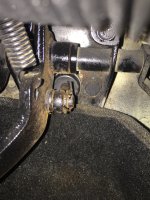I have to say one man bleed kits and me have never got on very well, I just never seem to get them to work properly. You can't beat the tried and tested two person method.
I am getting my petrol pipes and brake pipes mixed up, the plastic pipe goes to the master cylinder not the centre tunnel. The only step left if you are getting very little pressure is to carry out a thorough check of the copper pipes for possible damage.
The only step left if you are getting very little pressure is to carry out a thorough check of the copper pipes for possible damage.
I am getting my petrol pipes and brake pipes mixed up, the plastic pipe goes to the master cylinder not the centre tunnel.


